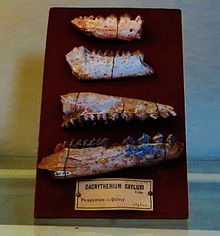| Dacrytherium Temporal range: Middle Eocene to Late Eocene
| |
|---|---|

| |
| Dacrytherium ovinum mandibles, National Museum of Natural History, France | |
| Scientific classification | |
| Domain: | Eukaryota |
| Kingdom: | Animalia |
| Phylum: | Chordata |
| Class: | Mammalia |
| Order: | Artiodactyla |
| Family: | †Anoplotheriidae |
| Subfamily: | †Dacrytheriinae |
| Genus: | †Dacrytherium Filhol, 1876[1] |
| Type species | |
| †Dacrytherium ovinum | |
| Other species | |
| |
| Synonyms | |
|
Genus synonymy
Synonyms of D. ovinum
| |
Dacrytherium (Ancient Greek: δάκρυ (tear, teardrop) + θήρ (beast or wild animal) meaning "tear beast") is an extinct genus of Palaeogene artiodactyls belonging to the family Anoplotheriidae. It occurred from the Middle to Late Eocene of Western Europe and is the type genus of the subfamily Dacrytheriinae, the older of the two anoplotheriid subfamilies. Dacrytherium was first erected in 1876 by the French palaeontologist Henri Filhol, who recognised in his studies that it had dentition similar to the anoplotheriids Anoplotherium and Diplobune but differed from them by a deep preorbital fossa and a lacrimal fossa, the latter of which is where the genus name derives from. D. ovinum, originally classified in Dichobune, is the type species of Dacrytherium. Henri Filhol named D. elegans in 1884, and Hans Georg Stehlin named the species D. priscum and D. saturnini in 1910.
Dacrytherium was a medium-sized artiodactyl that is defined by specific dental traits separating it from the Anoplotheriinae. Typically, its species have deep preorbital fossae that anoplotheriines lack entirely, although the depression of D. elegans is different from other species. Its dental and cranial anatomies, however, were otherwise typical of the Anoplotheriidae, which led to historic confusions regarding whether Dacrytherium belonged to the Anoplotheriidae or its own family. It is also recognised as having two evolutionary paths in the forms of D. elegans-D. saturnini and D. priscum-D. ovinum given the anatomical changes and size increases of dentitions over time, although the researcher who proposed the lineages later expressed doubt that the validity of the latter.
Dacrytherium lived in western Europe during a period when the region was an archipelago isolated from the rest of Eurasia. Contemporary species from this region were not widely dispersed due to high levels of endemism. It co-existed with a wide variety of artiodactyls and perissodactyls in subtropical-tropical environments that supported frugivorous-folivorous mammals. Dacrytherium itself was likely folivorous, but its lifestyle is unknown given the general scarcity of post-cranial evidence and the unusual variations of hypothesized behaviours in the derived anoplotheriines Anoplotherium and Diplobune.